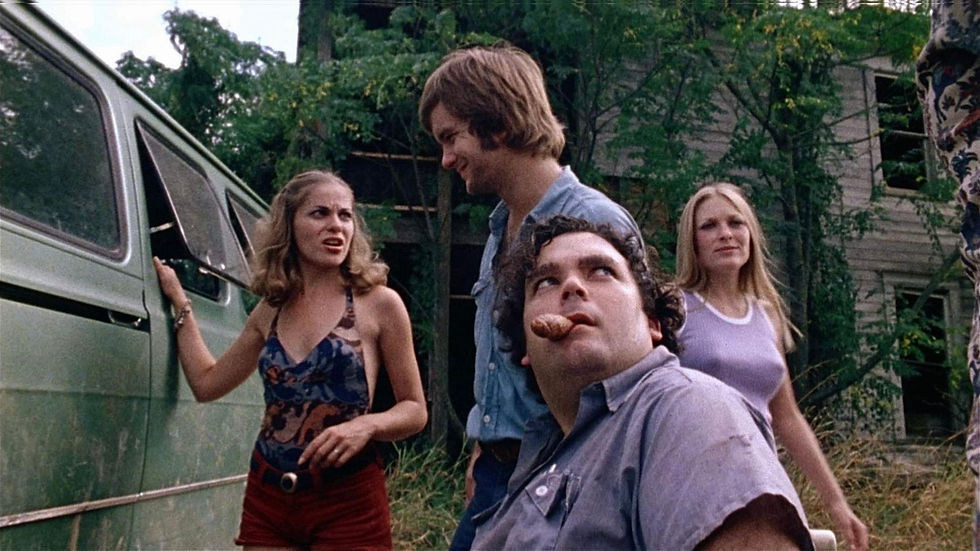The Texas Chainsaw Massacre (1974)
- Soames Inscker

- 5 days ago
- 4 min read

Introduction: A Screaming Revolution
When The Texas Chain Saw Massacre hit screens in 1974, it left audiences stunned, horrified, and bewildered. What many expected to be another exploitation shocker became one of the most relentless, influential, and subversive horror films ever made. Directed by Tobe Hooper on a shoestring budget, Chainsaw would not only redefine American horror but also reflect the bleak socio-political anxieties of a deeply disillusioned post-Vietnam era.
What makes Chainsaw endure is that it’s far more than blood and guts. In fact, it shows far less gore than its reputation suggests. What it delivers instead is atmosphere, nihilism, and a surreal descent into madness that has lost none of its power nearly 50 years later.
Plot Summary

The film opens with a chilling narration claiming the events are true—an early example of “based on a true story” horror marketing (very loosely inspired by the crimes of Ed Gein). A group of five young friends—Sally Hardesty (Marilyn Burns), her wheelchair-bound brother Franklin (Paul A. Partain), and three others—embark on a road trip across rural Texas to visit Sally's grandfather's grave.
On the way, they pick up a disturbed hitchhiker, encounter an abandoned slaughterhouse, and ultimately stumble upon a secluded farmhouse that hides an unspeakable horror: a family of cannibals led by the mute, hulking figure of Leatherface (Gunnar Hansen), who wears a mask made of human skin and wields a roaring chainsaw. One by one, the group is hunted down until only Sally remains, leading to one of the most nightmarish final acts in horror history.
Themes
American Decay and Post-Industrial Horror
The setting—a dusty, abandoned stretch of rural America—isn’t just a backdrop; it’s a character. The decaying farmhouses, the rusted-out cars, the slaughterhouse stench—all of it reflects a dying American dream. The film critiques a nation that has discarded both its youth and its working class, leaving behind madness and decay.
The cannibal family were once slaughterhouse workers, now obsolete in the face of industrial progress. This becomes an eerie metaphor for the dehumanization of labour and the disposability of people. The same tools used to kill livestock are now turned on humans.
Nihilism and Chaos
Unlike many horror films with clear moral compasses or supernatural forces, Chainsaw offers no divine justice, no reason, and no closure. The killers aren’t punished; they’re barely explained. The universe Hooper presents is indifferent, violent, and fundamentally mad.
Violence and Desensitization
Though remembered for its savagery, the film is shockingly restrained in terms of visible gore. Hooper deliberately pulled back to achieve a PG rating (though it was still banned in many countries). The horror instead comes from what’s implied: the sounds, the screams, the brutality just off-screen. It forces the audience to feel the violence, not just see it.
Family and Domestic Horror
The killer family represents a grotesque inversion of the American nuclear family. There’s a “father” figure (Jim Siedow), a deranged “motherly” cook, a violent older “brother” (the Hitchhiker), and Leatherface, who dons different “faces” depending on his role in the family (including a grotesque woman’s mask during dinner scenes). It’s a nightmarish parody of domestic life.
Performances
Marilyn Burns gives a legendary scream-queen performance as Sally. Her sheer terror, especially during the infamous dinner sequence, is so visceral and unrelenting that it feels documentary-like. Burns carries the final act with raw, almost feral energy.
Gunnar Hansen as Leatherface is both terrifying and tragically childlike. His imposing physicality is unmatched, but his body language suggests a confused man acting out of fear and conditioning rather than sadism. This ambiguity makes him one of horror's most enduring figures.
Paul A. Partain is often criticized for his portrayal of Franklin, but his whining, difficult personality makes his death all the more disturbing. He’s an atypical character in horror—a disabled man who’s both grating and sympathetic.
Edwin Neal as the Hitchhiker is unforgettable—unhinged, twitchy, and horrifyingly plausible. His presence in the van sets the tone for everything that follows.
Direction and Cinematic Style
Tobe Hooper directs with documentary-like realism, using handheld cameras, natural lighting, and grimy colour palettes that make the film feel almost like found footage. The lack of a conventional score—replaced by a droning, industrial sound design of hammers, screeches, and ambient noise—amplifies the discomfort.
The cinematography by Daniel Pearl is masterful, especially given the budget. The low angles, tight close-ups, and claustrophobic framing during the dinner scene create a sense of being trapped inside a waking nightmare. The final shot—Leatherface twirling with his chainsaw against a burning sunrise—is iconic: surreal, poetic, and deeply unsettling.
Cultural Impact and Legacy
The Texas Chain Saw Massacre was made for under $140,000 and went on to gross over $30 million, becoming one of the most profitable independent films ever. It launched an entire subgenre of rural/backwoods horror and influenced everything from Halloween to The Blair Witch Project to The Devil’s Rejects.
Leatherface has become one of the great horror icons, alongside Freddy Krueger, Jason Voorhees, and Michael Myers—but Chainsaw stands apart in tone and spirit. While others became franchises, Chainsaw remains singular, unpolished, and genuinely disturbing.
In a cultural sense, the film tapped into the American psyche like few others—mirroring the senseless violence of war, the fragmentation of traditional values, and a generation’s growing alienation. Its influence is still felt in modern horror’s embrace of nihilism, discomfort, and vérité realism.
Conclusion
The Texas Chain Saw Massacre isn’t just a horror movie—it’s a cinematic primal scream. Equal parts grindhouse and arthouse, it strips horror down to its most raw and elemental components. There’s no mythology, no rules, no relief—only panic, meat, and madness.
Nearly half a century later, its power remains undiminished. It doesn’t just scare—it scars. And that, perhaps, is its greatest triumph.





